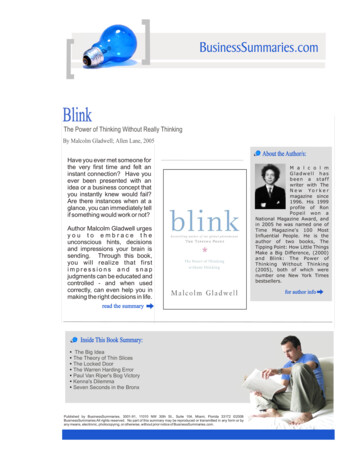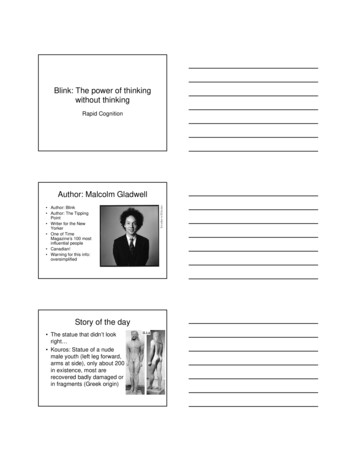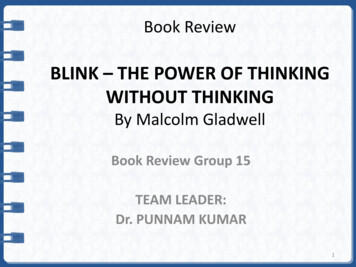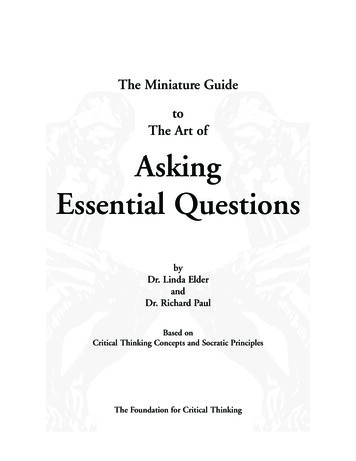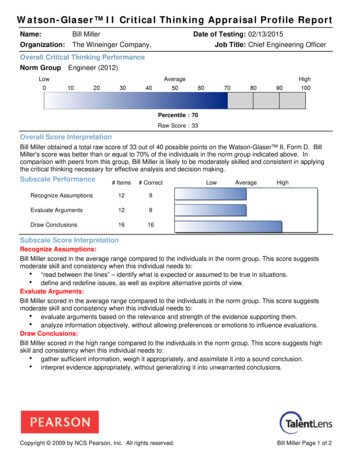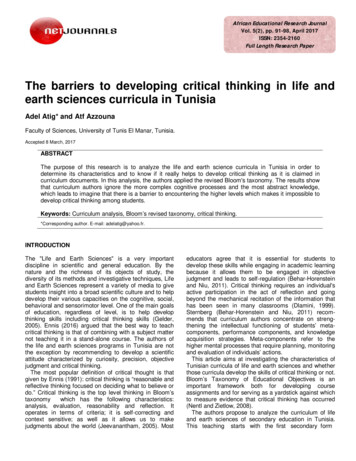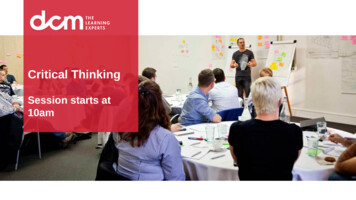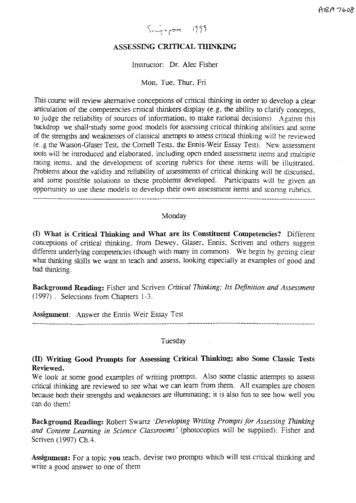
Transcription
ASSESSING CRITICAL THINKINGInstructor: Dr. Alec FisherMon. Tue, Thur, FriThis course will review alternative conceprions of critical thinking in order to develop a cleararticulation of the competencies crirical thinkers display (e.g. the ability to clarify concepts,to judge the reliability of sources of informauon. to make rational decisions) Against thisbackdrop we shallstudy some good models for assessing critical thinking abilities and someof the strengths and weaknesses of classical artempts to assess critical thinking will be reviewed(e.g the Watson-Glaser Test, the Come11 Tests. the Ennis-Weir Essay Test). New assessmenrtools will be introduced and elaborated, including open ended assessment items and multiplerating items. and the development of scoring rubrics for these items will be illustrated.Problems about the validity and reliability of assessments of critical thinking will be discussed.and some possible solutions to these problems developed. Participants will be given anoppomniry to use these models to develop their own assessment items and scoring rubrics.(I) What is Critical Thinking and What are its Constituent Competencies? Differentconceprions of critical thinking. from Dewey, Glaser, Ennis. Scriven and others suggestdifferent underlying competencies (though with many in common). We begin by gezing clearwhat thinking skills we want to teach and assess. looking especially at examples of good andbad thinking.Background Reading: Fisher and Scriven Critical 7'hinking: Its Dej3nition and Assessme zr(1997) . Selecrions from Chapters 1-3.Assignment: Answer the Ennis Weir Essay TestTuesday. .(11) Writing Good Prompts for Assessing Critical -g;also Some Classic TestsReviewed.We look at some good examples of writing prompts. Also some classic attempts to assesscritical thinking are reviewed to see what we can learn from them. All examples are chosenbecause both their strengths and weaknesses are illuminating; it is also fun to see how well youcan do them!Background Reading: Roben Swartz 'Developing Writing Prompts for Assessi zg7'hinkingand Content Learning in Science Classrooms' (photocopies will be supplied): Fisher andScriven (1997) Ch.4.Assignment: For a topic you teach. devise two prompts which will test critical thinking andwrite a pood answer to one of them
Thursday(III)Multiple Rating Questions: How to Write and Score Them.There are problems both with multiple choice and with essay assessments of thinkingprocesses. We explain an alternative way of writing critical thinking questions and assessingthe answers which seems to overcome many of the difficulties.Background Reading: Fisher and Scriven (1997) Ch.6Assignment: DeTise one multiple rating question which is relevant to your teaching, forcirculation to colleagues in the class tomorrow (write a seuarate scoring key).Friday(IV) Validity and Reliability; Problems and Sotutions.How can you be sure that your critical thinking test is assessing critical thinking and notsomething else (like shared beliefs)? What can be done when two teachers disagree about thecritical thinking ability displayed in a given performance? How do we decide who is right?We answer these questions with the help of some previous examples and by reference toexamples produced by members of the class.Background Reading: Fisher and Scriven (1997) Ch.7Z l s s i e n t : (for those who wish to gain credit for the course). Write an assignment whicnaims to assess one critical thinking competency w c ish important in a course you teach. Givea scoring key and justify it (not more than 2.000 words).Note on Reading: The text for the course is the book by Alec Fisher and Michael ScrivenCritical Thinking: Its D4nirion and Assessrnetzr. published by the Centre for Research inCritical Thinking. UEA. Norwich, UK and Edgepress, CA. USA. Another excellent bookwhich may be relevant to your interests is Evaluating Critical Thinking by Stephen Norris andRobert Ennis. published by Critical Thinking Press, 1989.
-pTHE ENNIS-WEIR CRITICAL THINKINGESSAY TESTTEST MANUAL CRITERIA SCORING SHEETAN INSTRUMENT FOR TEACHING AND TESTINGbyROBERT H. ENNISERIC WEIR1985MIDWEST PUBLICATIONSP.O. BOX 448PACIFIC GROVE, CA 93950ISBN 0-89455-290-2
APPENDIXW S - W E I R CRITICAL THIMCING ESSAY TESTTHE ENNIS-WEIR CRITICAL THINKING ESSAY TESTAN INSTRUMENT FOR TESTING AND TEACHINGDIRECTIONSRead the letter to the editor of the Moort u g newspaper. Consider it paragraph bylaragraph and as a total argument. Thenwite a letter to the editor in response to thishe. For each paragraph in the letter you areibout to read, write a paragraph in reply tellng whether you believe the thinking good orlad. Also write a closing paragraph about the talargument. Defend your judgments with%sons.Your answer should have nine numberedaragraphs. Numbers one through eightbuld Dve your reactions to paragraphs onerough eight in the letter. Your paragraphmber nine should give your overall evalua--.-tion of the letter considered as one total arWment. Each paragraph, including the last,shodd contain your reason(s).Spend about 10 minutes reading the letterand thinking about it. Then write for not morethan 30 minutes (about three minutes foreach of your short paragraphs). The maximum total time for the test is 40 minutes.Do not forget to give your reasons in eachparagraph. Please write clearly.Sign your name to your letter. You are alocal citizen, and this topic concerns you.Remember, write nine numbered paragraphs and give reasons.NOIE: Individuals and institutions who have secured fhis test from MIDWEST PUBUCATIONSare permitted to reproduce the test and the woring sheet forclajsroom useonly. The test consistsof this page of directions and the letter on thenext page. For each student a separatescoringsheet(page 14) d be needed for the grader to grade the student's response.k
-S-WEIRCRITICALTHINKING ESSAY TESTTHE MOORBURG LETTER230 Sycamore StreetMoorburgApril 10Dear Editor:Overnight parlung on all streets in Moorburg should be eliminated Toachieve this goal, parking should be prohibited From 2 a.m. to 6 am.There are a number of reasons why any intelligent citizen should agree.1. For one thing, to park overnight is to have a garage in the streets.Now it is illegal for anyone to have a garage in the city streets. Clearly,then, it should be against the law to park overnight in the streets.2. Three irnpo tantstreets, Lincoln Avenue, Marquand Avenue, andWest Main Street, are very narrow. With cars parked on the streets.there really isn't room For the heavy traffic that passes over them in theafternoon rush hour. When driving home in the afternoon after work, ittakes me thuty-five minutes to make a trip that takes ten minutesduring the uncrowded time. If there were no cars parked on the side ofthese streets, they could handle considerablv more traffic.3. Traffic on some streets is also bad in the morning when factorvworkers are on their way to the 6 a.m. shift. If there were no carson these streets between 2 a.m. and 6 am. then there would be moreroom for this traffic.4. Furthermore, there can be no doubt that, in general, overnightparking on the streets is undesirable. It is definitely bad and should beopposed.5 . If parking is prohibited from 2 am. to 6 a.m., then accidentsbetween parked and moving vehicles will be nearly eliminated duringthis period. All intelligent citizens would regard the near elimination ofaccidents in any period a s highly desirable. So, we should bein favor ofprohibiting parking from 2 a.m. to 6 a m .6. Last month, the Chief of Police, Burgess Jones, ran an experimentwhich proves that parking should be prohibited from 2 a.m. to 6 a.m. Onone of our busiest streets, Marquand Avenue, he placed experimentalsigns for one day. The signs prohibited parking from 2 a.m. to 6 a.m.During the four-hour period, there was not one accident on Marquand.Everyone knows, of course, that there have been over four hundredaccidents on Marquand during the past year.7. The opponents of my suggestions have said that conditions are safeenough now. These people don't know what "safe" really means. Conditions are not safe if there's even the slightest possible chance for anaccident. That's what "safe" means. So, conditions are not safe the waythey are now.8. Finally, let me point out that the Director of the National TrafficSafety Council, Kemeth 0. Taylor, has strongly recommended thatovernight street parking be prevented on busy streets in cities the size ofMoorburg. The National Association of Police Chiefs has made the samerecommendation. Both suggest that prohibiting parking from 2 a.m. to6 a.m. is the best way to prevent overnight parking.I invite those who disagree, as well as those who agrce with me, toreact to my letter through theeditor of this paper. Let'sget this issue outin the open.Sincerely,Robert R. Raywift
I I / / I II,S1,,,,aOeveloping Writing Prom tsfor Rssessing Thinking andI, te,t !mr, i,fi i, Sli nriCaissroorscience education is changing. We still see manyclassrooms where students passively learn information about the natural world from written texts.However, we also see a growing emphasis on helping students achieve a deeper connection to the naturalworld through active and constructive learning. Withthis approach, students are the center of the scienceclassroom. Teachers and texts facilitate the process ofactive learning instead of merely providing studentswith its inert products. Figure 8.1 outlines how thesev o types of science classrooms differ.To be sure, scientific principles and informationabout the natural world must play a role in the newscience classroom. But rather than give such informa-tion to students as the focus of.their learning, it shouldbe available to students who will seek it as they actively construct new understandings. In the new saenceclassroom, emphasis is placed on the development of:prmesses through which students can constructmeaning,processes students can use to validate their understanding ,andstrategies though which students can use theirinsights in constructive problem solving.Basic concepts of science together with scientificprinciples that flesh out these concepts are valuable inthe new science classroom only insofar as they areappropriately embedded in these processes.As instmcfional goals change, so too must assessment of whether we are achieving these goals. Wem i s t not only change what we assess but how weassess it. Relying primarily on stan&rd ways of assess-
&mLW THEl , , , ,ORCANIZ TlON: S W F W GTHE!1111/11111/PARI\OICY1FIGURE a rTradition21 Science Class vs. New Science C : 5 sF4AMTIONAL CLASSStudents are told what others think the naturzwork is like.Students are told how science works.Students are t o l d b o u contemporarytissues nscience.Teachers and texts give students iniormation :clearn.ing whether students retain basic information is nolonger appropriate. Modes of assessment that revealand enhance the use of the processes listed above mm:replace more traditional modes of assessment.This means that the primary emphasis in assessment must be on student perfomances that demonstrate the use of these active processes. This chapterexplains how teachers can prompt extended written(or oral) responses by students in ways that bring ourtheir active thinking and learning so that its qualitycan be assessed. In emphasizing the design of assessment prompts of this sort, we in no way wish to suggest that these modes are preferable to using students'active performance in science activities or to using aclassroom system where students keep a portfolio wiihself-evaluation of relevant work. All three of thesemodes of assessment should mesh in the science clasroom. We conceneate here on ways of prompt.;ngextended written or oral performances because it is thenatural next step to move to from assessing learningsclely with multiplechoice items and because it is anefficient way of determining the level of studentunderstanding in day-tc-day classroom situations.The mode of assessment we describe in thischapter uses pencil-and-paper assessments of studentlearning in a fairly traditional testing situation.However, this is not the only-nor oftentimes thebet-purpose for such assessment. lzather, assessmentsLbuld be viewed as a much broader enterprise.NEW CLASSStudents are guided to deve!oped their ownconception of the wcrld.Students test and rnodib their constructs throughscientific thinking.Students make cse of their understancing inscience to think through issues.Teachers and texts facilitate understanding andare resources for information students use :nproblem solving.Ongoing, informal assessment using these techniques,for example, is important to planning classroominstruction It is also a wonderhl vehicle for helpingstudents learn to monitor their o u n learning.Our primary message in tkis cha?ter extends toall levels of science insrmction. However, the focushere is on assessment for the elementary and middlegrades. This is because we bekevc that if new scienceteaching is to influence the attitudes of studentstoward science in their lives and in the classroom, it isaitical to begin early. This said, secondary schoolteachers should certainly find useful ideas here as well.TWO CONTRASTING ASSESSMENT EXAMPLESBetween grades 3 and 6, many elementary science programs inhoduce children to the concepts ofendangerment and extinction of species. Dinosaurs areoften used as an example of a sp&es that is extinct.Students also learn that some specie, such as theAfrican elephant, are threatened with extinction primarily because of hunting, while others are threatenedwith extinction because man has disrupted their habitats so severely that they no longer can find food. It isin this context that students are usually introduced tothe concept of a species. In particulzr, the implicationsof the extinction of a species are typically contrastedwith the dcath of one individual in a spicj.Here are two typical test
(e.g the Watson-Glaser Test, the Come11 Tests. the Ennis-Weir Essay Test). New assessmenr tools will be introduced and elaborated, including open ended assessment items and multiple rating items. and the development of scoring rubrics for these items will be illustrated. Problems about the validity and reliability of assessments of critical thinking will be discussed. and some possible .
